![]()
![]()
![]()
![]()
![]()
![]()

![]()
Sign the Guestbook
View the Guestbook

Atari Products | A Bit of History | Memo Pad | 1st Word | Links | Home
![]()
| Officially Released | Prototypes/Vaporware | ||
| Atari 400 | 1979 | 1200 | |
| Atari 800 | 1979 | 800XLF | |
| Atari 1200XL | 1982 | 1400XL | |
| Atari 600XL | 1983 | 1450XL | |
| Atari 800XL | 1983 | Atari 1450XLD |
|
| Atari 65XE/800XE | 1985 | 65XEP | |
| Atari 130XE | 1985 | 65XEM | |
| 1060 CP/M Add-On Module | |||
| 1090 XL Expansion System | |||
|
It was 1979 when Atari, Inc. entered the home computer market with the
introduction of the 800 and the 400 computer systems. (The 400/800 models
were first shown publicly in November 1978). These MOS Technology
6502-based systems run at a clock speed of 1.79 MHz, offering 256 colors
displayable simultaneously, up to 320x192 graphics resolution and up to 40x24
text resolution in 11 graphics modes and 5 text modes. Video may be displayed
either on a composite video monitor in the case of the 800, or on a
standard television for both systems. 4 independent sound voices are
available through the audio output of the television or monitor, each with
a 3 1/2 octave range, plus there is a built-in speaker for key-click and
other programmable sounds. The 800 has a second cartridge port and a
full-stroke keyboard, while the 400 has a single cartridge port and a
membrane keyboard. Each has 4 serial controller ports and an Atari Serial
Input/Output port. Originally, both the 400 and 800 were sold with 8K RAM,
but later most 800's were sold with 48K and 400's with 16K. Each
includes the 10K Atari Operating System in ROM.
The introduction of the 1200XL in 1982 marks the single largest advance in the 8-bit Atari system. The 1200XL runs most software and hardware designed for the 800 and 400, but now runs a slightly more advanced 6502C microprocessor, and includes a full 64K RAM. The single cartridge and monitor ports remain, along with 2 controller ports. In addition, the 1200XL includes 4 programmable Function keys and a Help key, built-in diagnostic and graphics demonstration programs, and probably the favorite keyboard of any 8-bit Atari computer. Clicks previously outputted through the built-in speaker are now heard from the television or monitor's speaker. The revised 16K Operating System offers many new features, including an alternate International Character Set. In 1983 Atari replaced the 1200XL/800/400 line-up with the new 800XL and 600XL. These new machines include most of the features of the 1200XL minus the Function keys and the demo program. But now both the 800XL and 600XL have the Atari BASIC language built-in. In addition, these two systems offer the Parallel Bus Interface, providing direct memory access to the heart of the computer. The 800XL contains 64K RAM while the 600XL has 16K RAM. The new Atari Corp. delivered on its promise to advance the 8-bit Atari system by replacing the 800XL/600XL with the new 130XE and 65XE in 1985. The 65XE is nearly identical to the 800XL in features, minus the PBI. The 130XE, however, offers 128K RAM, plus a few special new graphics capabilities. In addition, the 130XE replaces the PBI port with the Enhanced Cartridge Interface, continuing the powerful feature of direct memory access. In a change of marketing strategy, Atari introduced the new XE Game System in 1987. Despite its label, the XEGS is a true 8-bit Atari computer system. It offers the convenience of a detachable keyboard and built-in Missile Command game, while offering 64K RAM and full compatibility with the 65XE. Atari Corp. officially dropped all remaining support of their 8-bit computer line on January 1, 1992. Most of the technical information on these pages, including the above text, was taken from the Atari 8-Bit Computers FAQ maintained by Michael D. Current and others. Additional information was taken from various magazine articles, books, and from taking apart several Atari computers. |
Atari Products | A Bit of History | Memo Pad | 1st Word | Links | Home